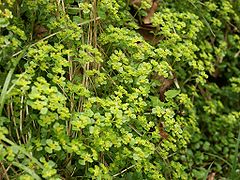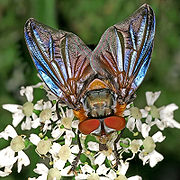
Trodds Copse
Encyclopedia
Trodds Copse is a 25.23 hectare
biological Site of Special Scientific Interest
(SSSI), in central Hampshire
, notified in 1989. It comprises ancient semi-natural woodland, unimproved meadows and flushes.
between Flexford Road and Hook Road and adjoins the Eastleigh to Romsey railway line
.
or coppice woodland.
The site is threatened by the north-westerly expansion of Chandler's Ford. In 1990, a planning application to build 200 houses and a golf course at neighbouring Broadgate Farm, Ampfield
was refused as it "would result in the destruction of part of the Trodds Copse Countryside Heritage Site".
 Among the many tree and plant species found at Trodds Copse are:
Among the many tree and plant species found at Trodds Copse are:


 The wide range of habitats is reflected by the diverse invertebrate
The wide range of habitats is reflected by the diverse invertebrate
fauna present within the site, including:
Hectare
The hectare is a metric unit of area defined as 10,000 square metres , and primarily used in the measurement of land. In 1795, when the metric system was introduced, the are was defined as being 100 square metres and the hectare was thus 100 ares or 1/100 km2...
biological Site of Special Scientific Interest
Site of Special Scientific Interest
A Site of Special Scientific Interest is a conservation designation denoting a protected area in the United Kingdom. SSSIs are the basic building block of site-based nature conservation legislation and most other legal nature/geological conservation designations in Great Britain are based upon...
(SSSI), in central Hampshire
Hampshire
Hampshire is a county on the southern coast of England in the United Kingdom. The county town of Hampshire is Winchester, a historic cathedral city that was once the capital of England. Hampshire is notable for housing the original birthplaces of the Royal Navy, British Army, and Royal Air Force...
, notified in 1989. It comprises ancient semi-natural woodland, unimproved meadows and flushes.
Location
The copse is situated to the north-west of Chandler's FordChandler's Ford
Chandler's Ford is a largely residential area and civil parish in the Borough of Eastleigh in Hampshire, England, with a population of 20,071 in the 2001 UK Census....
between Flexford Road and Hook Road and adjoins the Eastleigh to Romsey railway line
Eastleigh to Romsey Line
The Eastleigh-Romsey Line is the railway line from Eastleigh to Romsey in Hampshire, England. At Eastleigh, trains join the South Western Main Line for onward travel to Southampton and Totton...
.
Description
The citation for the SSSI says:Trodds Copse Site of Special Scientific Interest comprises ancient semi-natural woodland, unimproved meadows and flushes overlying Bracklesham BedsBracklesham BedsBracklesham Beds, in geology, are a series of clays and marls, with sandy and lignitic beds, in the Middle Eocene of the Hampshire Basin, England....
, Bagshot Sand, peatPeatPeat is an accumulation of partially decayed vegetation matter or histosol. Peat forms in wetland bogs, moors, muskegs, pocosins, mires, and peat swamp forests. Peat is harvested as an important source of fuel in certain parts of the world...
and alluviumAlluviumAlluvium is loose, unconsolidated soil or sediments, eroded, deposited, and reshaped by water in some form in a non-marine setting. Alluvium is typically made up of a variety of materials, including fine particles of silt and clay and larger particles of sand and gravel...
. The habitats are drained by tributaries of the Monks BrookMonks BrookMonks Brook is a river in the English county of Hampshire. It is a tributary of the River Itchen, which it joins at a medieval salmon pool in Swaythling. The brook is formed from seven streams that rise in the chalky South Downs, with the official source of Monks Brook being known as Bucket's...
, a branch of the River ItchenRiver Itchen, HampshireThe River Itchen is a river in Hampshire, England. It flows from mid-Hampshire to join with Southampton Water below the Itchen Bridge in the city of Southampton. The river has a total length of , and is noted as one of England's - if not one of the World's - premier chalk streams for fly fishing,...
. The diverse geology and varied drainage conditions give rise to a wide range of habitats. At least ten woodland types can be identified, of which four are considered nationally rare. The diversity of woodland types is matched by an extremely rich ground flora. The antiquity of the woodlands is reflected in the very high number of ancient woodland indicator species recorded within the site. Over fifty such species occur, including a number of rare or local plants such as tutsan (Hypericum androsaemumHypericum androsaemumHypericum androsaemum, commonly known as tutsan, is a plant in the genus Hypericum native to open woods and hillsides in Eurasia. It is a perennial shrub reaching up to 1.5 m in height.-Common name:...
) making it one of the botanically richest woods in Hampshire.
History
Trodds Copse and surrounding land has been well documented since the late 16th century. The whole site was enclosed from common land prior to 1588 and woodland boundary banks can be clearly discerned. Some areas were managed as wood pasture but by the early 19th century this practice had ceased, the land being converted to pasturePasture
Pasture is land used for grazing. Pasture lands in the narrow sense are enclosed tracts of farmland, grazed by domesticated livestock, such as horses, cattle, sheep or swine. The vegetation of tended pasture, forage, consists mainly of grasses, with an interspersion of legumes and other forbs...
or coppice woodland.
The site is threatened by the north-westerly expansion of Chandler's Ford. In 1990, a planning application to build 200 houses and a golf course at neighbouring Broadgate Farm, Ampfield
Ampfield
Ampfield is a village and civil parish in the Borough of Test Valley in Hampshire, England, between Romsey, Eastleigh, and Winchester. It had a population at the 2001 census of 1,474....
was refused as it "would result in the destruction of part of the Trodds Copse Countryside Heritage Site".
Flora

- Maple Acer campestre
- Alder Alnus glutinosa
- Common Hazel Corylus avellanaCorylus avellanaCorylus avellana, the Common Hazel, is a species of hazel native to Europe and western Asia, from the British Isles south to Iberia, Greece, Turkey and Cyprus, north to central Scandinavia, and east to the central Ural Mountains, the Caucasus, and northwestern Iran. It is an important component of...
- Alder buckthorn Frangula alnus
- Common Ash Fraxinus excelsior
- Pedunculate Oak Quercus robur
- Rowan Sorbus aucupariaSorbus aucupariaSorbus aucuparia , is a species of the genus Sorbus, native to most of Europe except for the far south, and northern Asia...
- Sneezewort Achillea ptarmica
- Velvet bent Agrostis caninaAgrostis caninaAgrostis canina, known as brown bent or velvet bent, is a species of grass.-Description:Agrostis canina is a perennial plant, with stolons but no rhizomes, and culms which grow to a height of up to . It is frequently confused with Agrostis vinealis Agrostis canina, known as brown bent or velvet...
- Tall oat Arrhenatherum elatiusArrhenatherum elatius-Introduction:Arrhenatherum elatius, with the common names false oat-grass, tall oat-grass, tall meadow oat, onion couch and tuber oat-grass, is a perennial species of grass, common in the temperate regions of Europe....

- Marsh marigold Caltha palustrisCaltha palustrisCaltha palustris is a herbaceous perennial plant of the buttercup family, native to marshes, fens, ditches and wet woodland in temperate regions of the Northern Hemisphere....
- Brown sedge Carex distichaCarex distichaCarex disticha is a species of sedge, whose common name is Two-ranked Sedge. It is native to parts of Northern and Western Europe, where it grows in moist spots in a number of habitat types, and it has been introduced to the Great Lakes region of southern Canada...
- Smooth-stalked sedge C. laevigataCarex laevigataCarex laevigata is a species of sedge. It lives in moist, shady environment in the lowlands of Western and Central Europe, particularly in alder–ash woodland. It is distinguished from similar species, such as C. binervis and C. distans by the presence of tiny red dots on the utricles...
- Tussock sedge C. paniculata
- Remote sedge C. remota
- Opposite-leaved golden saxifrageSaxifrageSaxifraga is the largest genus in the family Saxifragaceae, containing about 440 species of Holarctic perennial plants, known as saxifrages. The Latin word saxifraga means literally "stone-breaker", from Latin + ...
Chrysosplenium oppositifolium - Purple loosestrife Epipactis purpurataEpipactis purpurataEpipactis purpurata is an orchid....
- Meadowsweet Filipendula ulmaria
- Marsh bedstraw Galium palustreGalium palustreGalium palustre is a herbaceous annual plant of the family Rubiaceae. This plant is native to Europe and North America and has several common names, including Common Marsh-bedstraw....
- Fen bedstraw G. uliginosumGalium uliginosumGalium uliginosum or Fen Bedstraw is a plant species of the genus Galium....
- Water avens Geum rivale
- Ivy Hedera helixHedera helixHedera helix is a species of ivy native to most of Europe and western Asia. It is labeled as an invasive species in a number of areas where it has been introduced.-Description:...
- Yorkshire fog Holcus lanatus
- Tutsan Hypericum androsaemumHypericum androsaemumHypericum androsaemum, commonly known as tutsan, is a plant in the genus Hypericum native to open woods and hillsides in Eurasia. It is a perennial shrub reaching up to 1.5 m in height.-Common name:...

- Sharp-flowered rush Juncus acutiflorusJuncus acutiflorusJuncus acutiflorus, also called Sharp-flowered Rush, is a rush or a grassy plant of the genus Juncus. As the name suggests, the plant has notable sharp-looking flowers, flowering between July and September.-Physical description:...
- Yellow archangel Lamiastrum galeobdolon
- Honeysuckle Lonicera periclymenum
- Gipysywort Lycopus europaeus
- Yellow loosestrife Lysimachia vulgarisLysimachia vulgarisLysimachia vulgaris is a species of herbaceous perennial plants in the genus Lysimachia native to wetlands, damp meadows and forests of Eurasia. It is a 50-150 cm tall plant with an upright habit, blooming from June through August with erect panicles of conspicuous yellow flowers. L...
- Cyclamen-flowered Daffodil Narcissus cyclamineus
- Bramble Rubus fruticosus
- Wood club rush Scirpus sylvaticus
- Bog mosses including
- Sphagnum palustreSphagnum palustreSphagnum palustre is a species of moss from the genus Sphagnum, in the family Sphagnaceae....
- S. flexuosum
- Sphagnum recurvum var. mucronatum
- Sphagnum palustre
- Devil’s bit scabious Succisa pratensisSuccisa pratensisSuccisa pratensis Moench, also known as Devil's-bit Scabious, is a flowering plant of the genus Succisa in the family Dipsacaceae. It differs from other similar species in that it has 4 lobed flowers, whereas Small Scabious and Field scabious have 5 lobes and hence it has been placed in a separate...
- Branched bur-reed Sparganium erectumSparganium erectumSparganium erectum, the simplestem bur-reed or branched bur-reed, is a perennial plant species in the genus Sparganium.The larvae of the moth Plusia festucae feed on Sparganium erectum.-See also:...
Fauna

Invertebrate
An invertebrate is an animal without a backbone. The group includes 97% of all animal species – all animals except those in the chordate subphylum Vertebrata .Invertebrates form a paraphyletic group...
fauna present within the site, including:
- Hoverfly Criorhina asilica
- Robber fly Choerades marginatus
- Solitary bee Macropis europaea
- Tachinid fly Phasia hemipteraPhasia hemipteraPhasia hemiptera is a tachinid fly found throughout Northern and Southern Europe. It is a strongly sexually dimorphic species, males being more colourful with curved patterned wings. Like most tachinid flies, the female lays her eggs on other insects, the larvae then develop inside the living host,...
- Hoverfly Volucella inflataVolucella inflataVolucella inflata is a large species of European hoverfly.-Description:V. inflata is a large, short haired fly. Thought a little smaller than most European species of Volucella, Typical body length is 12-15mm and wing length is 11-13mm. The thorax is black with orange margins, and the scutellum is...
External links
- Natural England website (SSSI information)
- Map of the SSSI

